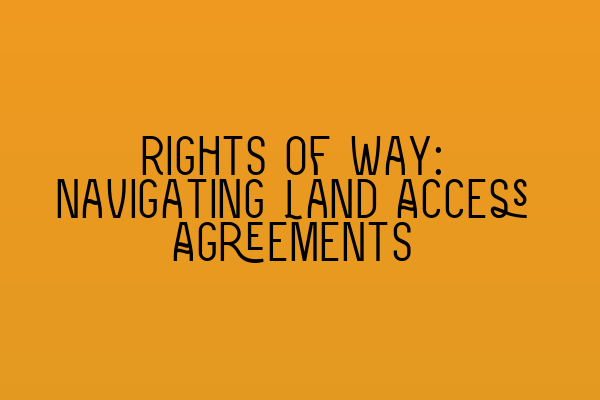Rights of Way: Navigating Land Access Agreements
As a property owner or buyer, understanding the concept of rights of way is essential when it comes to accessing and using land. A right of way refers to the legal right to pass through or use another person’s land for a specific purpose. It is crucial to have a clear understanding of rights of way, as they can have a significant impact on your property’s value and usage. In this blog post, we will explore the intricacies of rights of way and how to navigate land access agreements.
1. What is a right of way?
In the realm of property law, a right of way is a legal easement that grants a person or entity the right to access and use someone else’s property for a specific purpose. This purpose could include pedestrian access, vehicle access, utility access, or any other necessary use.
Rights of way can be either:
– Express: Arising from a written agreement or deed, explicitly stating the terms and conditions of the right of way.
– Implied: Arising from past use or necessity, even if it hasn’t been explicitly stated in a written agreement.
2. Types of rights of way
There are several types of rights of way that you may encounter:
– Private right of way: This is a right of way that benefits a specific individual or entity, usually granted through an easement. It allows the owner to access their property through someone else’s land.
– Public right of way: This type of right of way is available to the general public. Examples include footpaths, bridleways, and highways. Public rights of way are often protected by local authorities to ensure access for residents and visitors.
– Prescriptive right of way: This right of way arises when someone has consistently and openly used a path or accessway for an extended period, typically over 20 years. To establish a prescriptive right of way, evidence of uninterrupted use is crucial.
3. How to establish a right of way
Establishing a right of way can be a complex process. It often requires a thorough examination of historical deeds, land registry records, and other relevant documents. Hiring a solicitor with expertise in property law is essential to navigate this process effectively.
To establish a right of way, the following factors need to be considered:
– Need: Is there a genuine necessity for the right of way? This is a crucial factor, especially for implied rights of way.
– Duration: How long has the right of way been used? The longer the duration, the stronger the claim.
– Evidence: Gathering evidence of past use is essential to substantiate your claim for a right of way. This can include witness testimonies, photographs, and historic maps.
– Intent: Was there an intention to grant a right of way when the land was originally divided or sold? Examining the intentions of the original landowners can help support your claim.
4. Land access agreements
When it comes to accessing land through a right of way, it is important to have a clear and legally binding land access agreement. This agreement outlines the terms and conditions of the access, ensuring that both parties understand their rights and responsibilities.
A comprehensive land access agreement should include:
– Details of the right of way, including its purpose and location.
– Any restrictions or limitations on the use of the right of way.
– Obligations for the party granting the right of way, such as maintenance and repairs.
– Obligations for the party using the right of way, such as reasonable use and respect for the property.
– Details of any compensation or fees associated with the right of way.
– Dispute resolution methods in case of any conflicts arising between the parties.
Having a well-drafted land access agreement in place can help prevent future disputes and ensure a smooth flow of access.
5. Seek professional assistance
Navigating rights of way and land access agreements can be time-consuming and complex. Seeking professional assistance from a qualified property solicitor is strongly advised. A solicitor specializing in property law will be able to guide you through the process, review documents, and ensure that your rights are protected.
At SQE Property Law & Land Law, our team of experienced solicitors can provide expert advice and assistance on all aspects of rights of way. Contact us today to schedule a consultation and ensure that your property rights are in safe hands.
**Related Articles**
– Want to test your knowledge of SQE 1 exam questions? Check out our SQE 1 Practice Exam Questions article to practice your skills.
– Looking for SQE 1 practice mocks? Our SQE 1 Practice Mocks FLK1 FLK2 article provides valuable insights to help you prepare effectively.
– Get ready for your SQE 2 exams with our comprehensive SQE 2 Preparation Courses. Enhance your knowledge and boost your chances of success.
– Interested in preparing for the SQE 1 exams? Explore our range of SQE 1 Preparation Courses designed to support your learning and exam preparation.
– Stay updated with the latest SRA SQE exam dates by visiting our SRA SQE Exam Dates article. Plan your study schedule accordingly and stay ahead of the curve.
